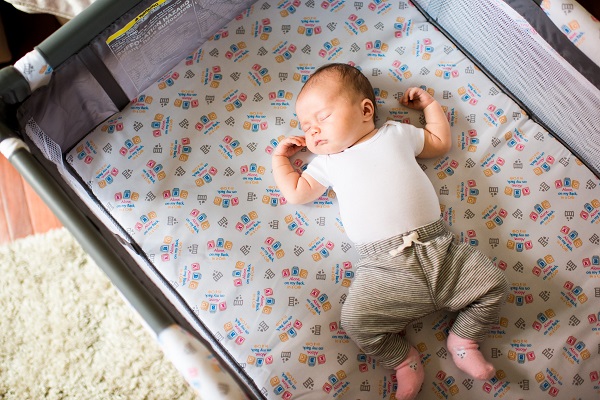
What you need to know about safe sleeping for babies from Cribs for Kids
Above photo by Little Rockstar Photography.
In 1994, Judy Bannon was working as executive director of Sudden Infant Death Services (SIDS) of Pennsylvania when doctors began instructing new mothers to put their babies on their backs to sleep.
The “Back to Sleep” Campaign resulted in a drop in sudden infant death rates of 50 percent in the U.S., but sleep-related deaths remained the No. 1 cause of infant deaths after the first month of age.

Bannon realized that most of the infant deaths she was seeing were from lower-income areas – and many of the babies were not found sleeping in cribs, but in parents’ beds or on couches.
“Our mission became clear – to provide cribs to babies whose mothers could not afford them and educate mothers about the dangers of unsafe-sleep environments,” she says. “In 2002, we officially changed our name from SIDS of PA to Cribs for Kids.”
Bannon, an Elizabeth Township mother and grandmother, has spent the last two decades alerting parents and caregivers to the importance of safe sleep for their infants.
As executive director and founder of Pittsburgh-based Cribs for Kids, Bannon and her team of employees, volunteers and partners are celebrating the organization’s 20th anniversary. An open house will be held on Dec. 12 at its Hazelwood headquarters.
Cribs for Kids has evolved from a local nonprofit in 1998 to a national organization. Its 1,100-plus partners have provided some 500,000 cribs to families in need.
The organization’s choice of safe-sleeping space has transitioned over the years from full-sized cribs to a more portable unit, the Cribette.
“This unit brings the infant safe-sleep message front and center to all caregivers with the safe-sleep message imprinted on the fabric, ‘A B C – Alone on my Back in a Crib.’ That makes the Cribette an educational tool as well as a safe sleeping environment,” Bannon says.
Educational initiatives include professional programs along with those for parents, such as the Safe Sleep Academy website that offers tips ranging from caring for a fussy baby to swaddling.
The Cribs for Kids program and Cribettes have been well received at birthing hospitals throughout Allegheny County.
“We ensure that all families are educated on safe-sleep guidelines, which are adopted from the American Academy of Pediatrics guidelines,” says Shawndel Laughner, director of Women and Children’s Services at St. Clair Hospital. “We could not be happier to be a part of this program, as the safety our infants is always our No. 1 priority.”
This year alone, UPMC Magee Womens Hospital has provided Cribettes to 380 families. West Penn Hospital, Allegheny Health Network’s busiest hospital for births, averages between 100 and 150 Cribettes a year.
“Our partnership with Cribs for Kids has allowed us to help our families who cannot provide a safe sleep environment for their baby at home – and provide them with a quality education on how to care for their baby,” says Belinda Callaghan, nurse manager, Women and Infants Center at Jefferson Hospital. “We appreciate knowing that our families will sleep safely after they leave the hospital, and will grow together as a happy, healthy family.”
But there is more work to be done. Plans are underway for the 6th National Cribs for Kids Conference, “Embracing Technology,” to be held April 23-26 in Pittsburgh.
The goal of the conference, Bannon says, is “to start a conversation about how we can actively reach larger audiences and spread the safe-sleep message more effectively using technology, social media, and marketing.”
Tips: Creating a safe sleep environment
The American Academy of Pediatrics offers these recommendations to create a safe sleep environment for your baby:
- Place the baby on his or her back on a firm sleep surface such as a crib or bassinet with a tight-fitting sheet.
- Avoid the use of soft bedding, including crib bumpers, blankets, pillows and soft toys. The crib should be bare.
- Baby should share a bedroom with parents, but not the same sleeping surface, preferably until the baby turns 12 months, but at least for the first six months. Room-sharing decreases the risk of SIDS by as much as 50 percent.
- Avoid baby’s exposure to smoke, alcohol and illicit drugs.